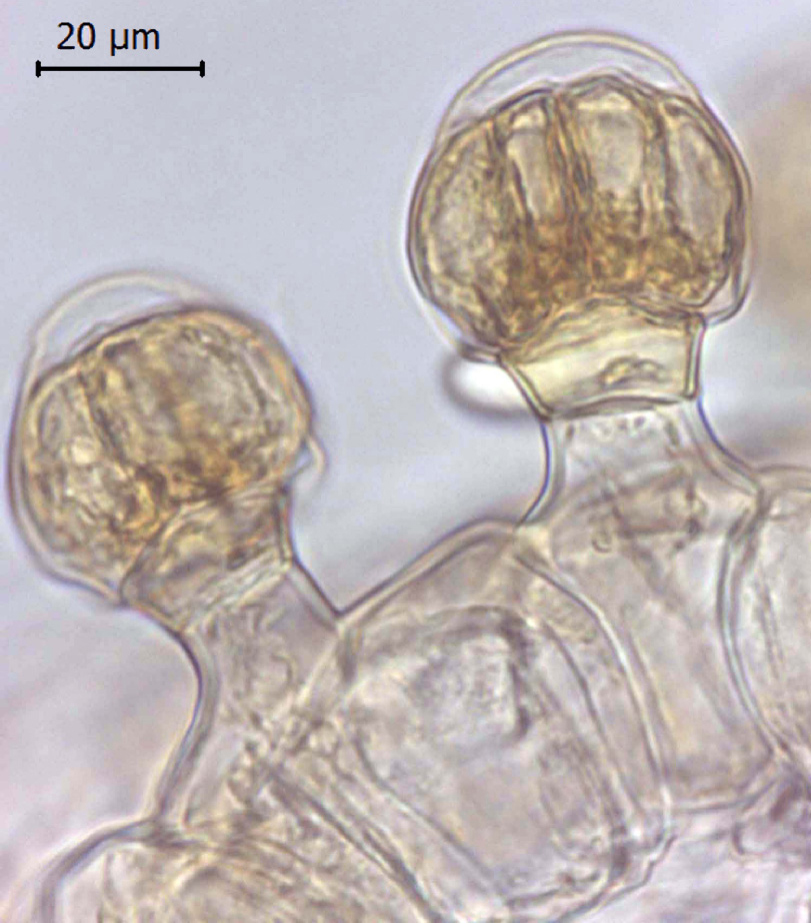Glandular trichomes on vegetative and reproductive organs of Lamium orientale (Lamiaceae)
Abstract
The types of glandular trichomes and their distribution on the vegetative and reproductive organs of Lamium orientale (syn. Wiedemannia orientalis) are studied for systematic purposes in this paper. Two morphologically different types of glandular trichomes (peltate and capitate) are described. Peltate trichomes are characterized by a short stalk, which is connected with a large spherical head composed of four cells in a single layer. Capitate glandular trichomes are subdivided into capitate type A and capitate type B. On the vegetative organs peltate trichomes are abundant, while on reproductive organs capitate trichomes are numerous and the peltate trichomes are rare or absent.
References
Amelunxen F., Wahlig T., Arbeiter H. 1969. Über den Nachweis des atherischen Öls in isolierten Drüsenhaaren und Drüsenshuppen von Mentha piperita L. Z. Pflanzenphysiol. 61: 68–72.
Antunes T., Sevinate-Pinto I. 1991. Glandular trichomes of Teucrium scorodonia L. morphology and histochemistry. Flora 185: 65–70.
Atasagun B., Aksoy A., Martin E. 2015. Contribution to the systematic knowledge of Lamium multifidum and L. orientale (Lamiaceae). Phytotaxa 203: 147–158.
Başer K.H.C. 1993. Essential oils of Anatolian Lamiaceae: A profile. Acta Hortic. 333: 217–238.
Bendiksby M., Brysting A.K., Thorbek L., Gussarova G., Ryding O. 2011. Molecular phylogeny and taxonomy of the genus Lamium L. (Lamiaceae): Disentangling origins of presumed allotetraploids. Taxon 60: 986–1000.
Cantino P.D. 1990. The phylogenetic significance of stomata and trichomes in Labiatae and Verbenaceae. J. Arnold Arbor. 71: 323–370.
Çelebioğlu S., Baytop T. 1949. A new reagent for microscopical investigation of plant. Publication of the Institute of Pharmacognosy 10: 300–301.
Corsi G., Bottega S. 1999. Glandular hairs of Salvia officinalis: New data on morphology, localization and histochemistry in relation to function. Ann. Bot. 84: 657–664.
Davis P.H. 1982. Flora of Turkey and the East Aegean Islands. Vol. 7: 349–381. Edinburgh Univ. Press, Edinburgh.
Duarte M.R., Lopes J.F. 2007. Stem and leaf anatomy of Plectranthus neochilus Schltr., Lamiaceae. Braz. J. Pharmacog. 17 (4): 549–556.
Dudai N., Werker E., Putievsky E., Ravid U., Palevitch D., Halevy A.H. 1988. Glandular hairs and essential oils in the leaves and flowers of Majorana syriaca. Israel J. Bot. 37: 11–18.
El-Gazzar A., Watson L. 1970. A taxonomic study of Labiatae and related genera. New Phytol. 69: 451–486.
Hallahan D.L. 2000. Monoterpenoid biosynthesis in glandular trichomes of Labiatae plants. In: Hallahan D.L., Gray J.C. (eds), Advances in botanical research: Plant trichomes. Academic Press.
Hanlidou E., Kokkini S., Bosabalidis A.M., Bessiere M. 1991. Glandular trichomes and essential oil constituents of Calamintha menthifolia (Lamiaceae). Plant Syst. Evol. 177 (1–2): 17–26.
Heinrich G., Schultze W., Pfab I., Boettger M. 1983. The site of essential oil biosynthesis in Poncirus trifoliata and Monarda fistulosa. Physiol. Veg. 21: 257–268.
Kamatou G.P.P., Van Zyl R.L., Van Vuuren S.F., Viljoen A.M., Figueiredo A.C., Barroso J.G., Pedro L.G., Tilney P.M. 2006. Chemical composition, leaf trichome types and biological activities of the essential oils of four related Salvia species indigenous to southern Africa. J. Essent. Oil Res. 18: 72–79.
Kamatou G.P.P., Viljoen A.M., Figueiredo A.C., Tilney P.M., Van Zyl R.L., Barroso J.G., Pedro L.G., Van Vuuren S.F. 2007. Trichomes, essential oil composition and biological activities of Salvia albicaulis Benth. and S. dolomitica Codd, two species from the Cape region of South Africa. S. Afr. J. Bot. 73:102–108.
Metcalfe C.R., Chalk L. 1972. Anatomy of the dicotyledons. Vol. II. Oxford University Press, London.
Mill R.R. 1982. Wiedemannia Fisch. & Mey. In: Davis P.H. (eds), Flora of Turkey and the East Aegean Islands. Vol. 7: 148–149. Edinburgh Univ. Press, Edinburgh.
Navarro T., El Oualidi J. 2000. Trichome morphology in Teucrium L. (Labiatae), a taxonomic review. An. Jard. Bot. Madrid. 57: 277–297.
Özdemir C., Altan Y. 2005. Morphological and anatomical investigations on endemıc Scutellaria orientalis L. subsp. bicolor (Hochst.) Edmund and subsp. santolinoides (Hausskn ex Bornm). Pak. J. Bot. 37 (2): 213–226.
Payne W.W. 1978. A glossary of plant hair terminology. Brittonia 30: 239–255.
Serrato-Valenti G., Bisio A., Cornara L., Ciarallo G. 1997. Structural and histochemical investigation of the glandular trichomes of Salvia aurea L. leaves and chemical analysis of the essential oil. Ann. Bot. 79: 329–336.
Vrachnakis T. 2003. Trichomes of Origanum dictamnus L. (Labiatae). Phyton 43 (1): 109–133.
Werker E., Putievsky E., Ravid U. 1985a. The essential oils and glandular hairs in different chemotypes of Origanum vulgare L. Ann. Bot. 55: 793–801.
Werker E., Ravid U., Putievsky E. 1985b. Structure of glandular hairs and identification of the main components of their secreted material in some species of the Labiatae. Israel J. Bot. 34: 31–45.
Werker E. 2006. Function of essential oil-secreting glandular hairs in aromatic plants of Lamiaceae: A review. Flavour Frag. J. 8 (5): 249–255.


This work is licensed under a Creative Commons Attribution-NonCommercial-NoDerivatives 4.0 International License.
The journal is licensed by Creative Commons under BY-NC-ND license. You are welcome and free to share (copy and redistribute the material in any medium or format) all the published materials. You may not use the material for commercial purposes. You must give appropriate credit to all published materials.
The journal allow the author(s) to hold the copyrights and to retain publishing rights without any restrictions. This is also indicated at the bottom of each article.





